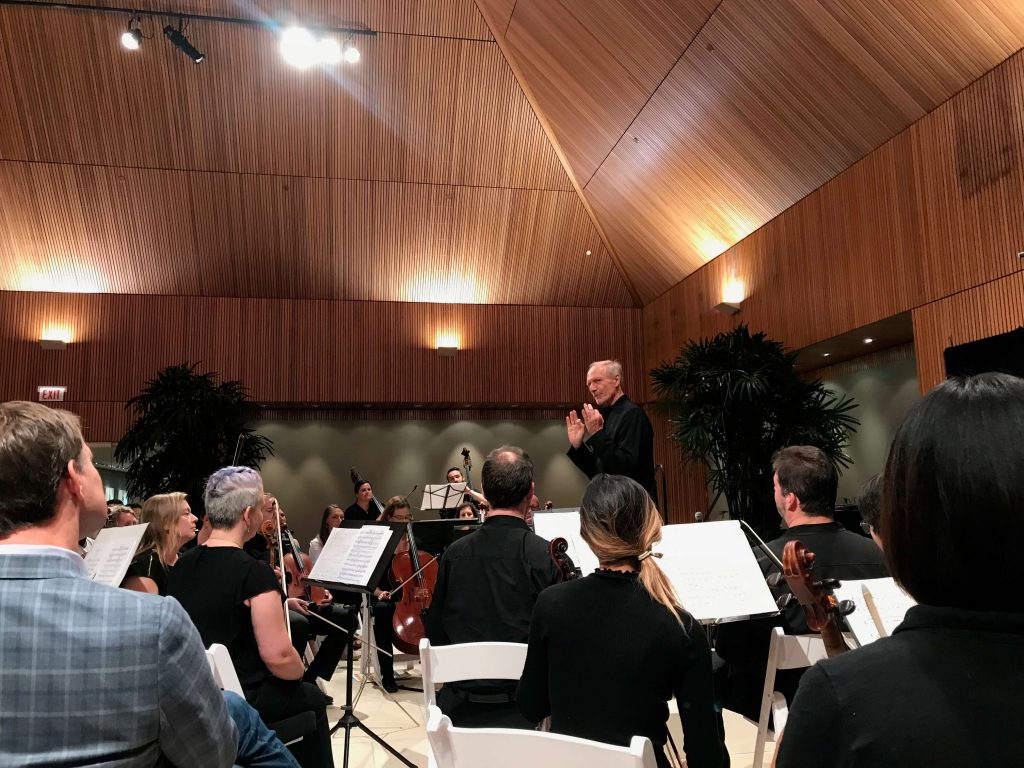
Watching an orchestra rehearse and a conductor interact with the ensemble, manage and lead, provides a powerful analogy of leadership skills and behaviors. This parallel has been mentioned in various writings on leadership. In addition, it’s even been used in an executive education course case study offered by such prestigious schools as Harvard in Boston and INSEAD in France, which plunge students into the orchestra pit along with professional musicians to better understand the dynamics of corporate management.
Unique Musical Immersion
I had the pleasure and the privilege last week to have a similar experience. I attended a Symphonic Leadership event – an Interactive Concert Learning Experience – organized by Pinnacle Performance Company, a global communication skills training firm. The uniqueness of Pinnacle’s methodology is that their training techniques are based on the same principles that actors use to communicate, perform under pressure, captivate and impact their audiences. The founders, David Lewis and Gary Riley Mills, and their trainers have an acting background and some trainers maintain a dual professional career in both training and acting.
The event took place in a Concert Hall at the beautiful Chicago Botanic Gardens. Maestro Gernot Schultz and the Lake Shore Symphony Orchestra welcomed a small group of guests in their midst to experience a one of a kind, interactive concert and learning. We had the opportunity to sit right in the middle of the orchestra among the musicians and a couple of rows away from the conductor.
Learning Experience
The orchestra performed various musical pieces that Maestro Gernot Schultz used to cleverly demonstrate the art and the skills of conducting and the parallels with leadership. Schultz alternated making music and conversation, conducting and explaining, showing how he could produce totally different versions of identical musical passages by varying rhythm, emotion, intensity expressed in his conducting style. He interacted with guests, involving them in various ways, asking questions, having them move around to experience the music from different perspectives/parts of the room, and then let a few lucky ones experience conducting the ensemble by themselves for a minute or two.
During this fascinating and entertaining session, Schultz highlighted some themes that are fundamental and essential for both orchestra conducting and leadership:
-
Intention
A conductor must be clear on the way he wants the music to be performed by the orchestra and the experience he wants the audience to have. He brings it all together. A musical score is just “black spots on a white page” says Schultz, and it is up to the conductor to bring it to life. Similarly, a leader, articulates a vision of what he wants to achieve through his communication, his goal and objectives and the impact he wants to have on his audience.
-
Emotions
Music conveys emotion in a nonverbal way that impacts our brains deeply and intuitively. The slow tempo of a soft violin melody will evoke tenderness, nostalgy, sadness, or grief. An upbeat tempo with an energetic decibel level will stir up feelings of joy, excitement, or celebration. The emotions conveyed by music are perceived by our limbic brain, which is also our emotional brain. This is why music can move us, change our mood or give us chills.
The conductor expresses the emotions he wants the orchestra to reflect by literally embodying them in his facial expressions, body language, and movements. Musicians pick up this nonverbal behavior automatically and align their playing to the conductor’s emotional expression. The mirror neurons in our brains support this process which tunes us into others. Similarly, for a leader to touch, influence and impact others he must incorporates emotion in his communication. When emotional expression and body language are congruent with the content of his message they will leverage the leader’s impact and influence.
-
Synchrony & harmony
An orchestra is made up of many people playing a variety of instruments. The conductor must synchronize this multiplicity in order to create a harmonious musical whole. The failure of doing this would result in a cacophony. The conductor is in control of the rhythm, and timing of the playing or silence of each instrument or instrument groups of the orchestra. Similarly, a leader must integrate the variety of people and situations that he is dealing with in order to create a harmonious result. Understanding the differences, the uniqueness of each person and situation, while being able to incorporate it into a bigger picture that leverages all the parts into something bigger than the sum of them.
-
Balance
Typically not all instruments play continuously in a musical piece. Some passages may involve one or select groups playing, while others are silent or play softly, just in a supportive role. This creates texture and depth to the musical performance. Some parts are quiet, some are louder, and the conductor is the driver of that continuous flux and required balance, constantly managing and fine tuning the sound levels in order to create the desired result. Similarly, a leader, must manage his team and the quietness and/or loudness of people and situation. There are times when some individuals may have a more important role than others, and the rest of the team needs to be in a supportive mode. Other times all need to be more equally involved. Leaders support and control this dynamic, which is essential to team performance.
-
Recognizing individual performance
Musicians are very individualistic, yet they are able to come together and merge into one orchestra, and become a unified sound and and harmony, says Schultz. Yet it is important to recognize individual performance. If a musician performs exceptionally well Schultz likes giving feedback on the spot, reinforcing that excellence. Conversely, in the event that anyone displays a performance that is not at the desired level, he does the same to hold them accountable. This keeps the best performers motivated and makes sure all know that individual performance is not diluted in the group performance.
Personal Insights
This experiential learning via musical immersion created a new insight for me. I had never experienced music that way, I mean in terms of breaking it down into pieces and connecting to aspects of something that is very different, leadership, and seeing the parallels. As my work involves leadership development and emotional intelligence, the connections were even more numerous and resonated deeply.
Music has been long part of my life as I come from a family of musicians and I started to play the piano at age 5. During childhood it was both a direct experience as I was playing an instrument and an environmental influence, as my parents had a passion for music. My parents were choral conductors, and both had professional musical training. My dad started a community chorus, and then my mother took it over when he passed away, to continue his legacy. I was at a young age then, and I remember spending countless hours standing among the chorus singers, mostly during church service performances, watching my mother conduct and lead the ensemble.
Where Emotional Intelligence meets Neuroscience
I often wondered how she was getting so expressive, literally creating a nonverbal dialog between her and the singers. I was amazed at how her body language would transform as she stood up in front of the ensemble and raised her hands to begin the performance. It felt like an invisible energy field connecting her to all of them and creating the music. And this is the emotional connection, the dynamic that Schultz highlighted and illustrated and the analogy with leadership is striking.
I feel grateful for these childhood experiences, which at the time didn’t feel quite exciting. As I’m reflecting I realize a new meaning emerges from the intuitive knowledge I picked up then, a deep sense that emotions drive, influence, impact, that they connect us to others, and that body language represents a powerful aspect of our communication. I can feel it with my entire body experiencing various sensations and feelings as I am listening to music. This knowing comes from the emotional brain, the limbic system, which is the part of the brain that drives us; it is also regulated and influenced by our reasoning brain the PFC, as there’s a dialog between both parts. Emotions and reason work together but emotions are in the driver’s seat, and music is a wonderful way to illustrate and convey this message.
Thank you Maestro Schultz!






























